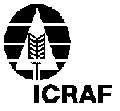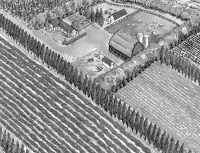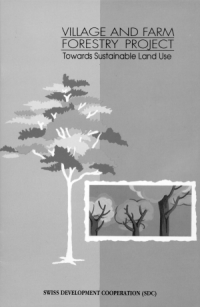International
Programs
International Centre
for Research in Agroforestry
 |
ICRAF has a global
mandate for agroforestry
research, with teams in 20
countries around the tropics. In
the last four years, it has
initiated a program to
domesticate some of the many
indigenous trees that local
people use for food, medicines,
and other products. /RRBL |
The International Centre for
Research in Agroforestry (ICRAF) is an
autonomous, non-profit international
research organization supported by the
Consultative Group on International
Agricultural Research (CGIAR).
ICRAF’s mission is to mitigate
deforestation, land depletion and rural
poverty through improved agroforestry
systems. It seeks to achieve this by
integrating woody perennials within
farming systems to increase their
productivity, profitability,
sustainability, diversity of farm
products and conservation of natural
resources.
ICRAF characterizes farming and
land-use systems and conducts
ethnobotanical studies which focus on the
criteria farmers use to select species
for specific purposes. These studies
allow an overview of local knowledge on
aspects such as tree management, culture
problems, propagation, uses and services.
Within these activities, ICRAF has
developed a methodology to select
multi-purpose tree species which merit
domestication. This has been carried out
in the humid and semi-arid lowlands of
West Africa, the Miombo woodlands of the
southern African plateau, and western
Amazonia. Domestication experiments are
being initiated with the selected
priority species.
The ICRAF Germplasm Resources Unit is
responsible for the collection,
documentation and conservation of
germplasm of these priority species, as
well as the exchange of germplasm for
research purposes. ICRAF also
investigates the interactions between
trees and crops in agroforestry, improves
agroforestry systems and assesses the
impact of agroforestry on the social and
economic welfare of farmers and on the
environment.
In addition to its research
activities, ICRAF organizes seminars and
conferences, conducts training courses,
maintains databases and produces a range
of publications. For more information on
the Agroforestree Database,Tree Seed
Suppliers Directory and Agroforestry
Today, see the Multimedia section of
this Handbook.
© Dr.
Anne-Marie Izac, Director of Research
Division, ICRAF House, United Nations
Avenue, Gigiri, P.O. Box 30677,
Nairobi, Kenya;
Tel. +254.2.521450, Fax
+254.2.521001,
E-mail a.izac@cgiar.org,
Website http://www.cgiar.org/icraf/
‘Perhaps nowhere in the
world are trees so threatened –
or so valuable – as they are in
the harsh and dry Sahel of West
Africa ...
However, many trees and shrubs are
well adapted to the extremely harsh
climatic conditions in these
semi-arid tropics, and resource-poor
farmers depend heavily on them for
valuable products and services –
not least of which are the food and
nutritional security they have always
afforded. Trees also provide valuable
shade, help improve soils and check
erosion. Farmers cut and burn trees
and shrubs to clear lands for
agriculture. Because of population
pressure, farmers are reducing their
fallow periods to a point where the
soil can no longer recover its
fertility between cropping cycles,
and the traditional agroforestry
– or parklands – system,
with scattered trees being protected
and managed in cropping land, is now
threatened by the overexploitation of
tree and shrub resources. The entire
region is suffering extensive
deforestation, especially around
large urban areas, and the spectre of
desertification is one that cannot be
ignored.
Prosopis africana, one of the
most valuable agroforestry tree
species in the region, is seriously
at risk in the face of the mounting
need for its products and for land,
both for grazing and for
cropping.’
Tchoundjeu, Z., J.
Weber and L. Guarino. 1997. Prosopis
africana in the Sahel – the
last stand? Agroforestry Today 9(2):18-20.
Edinburgh Centre for
Tropical Forests
 |
ECTF provides
customers with a very broad range
of expertise within a single
organization. It undertakes a
very wide range of research and
development projects, from
strategic research to
reforestation projects, promoting
carbon offsets and developing
tree planting manuals for
illiterate farmers. /RRBL |
The Edinburgh Centre for
Tropical Forests (ECTF) is a consortium
that brings together the Institute of
Terrestrial Ecology, LTS International
Ltd., Royal Botanic Garden, Edinburgh, UK
Forestry Commission, and University of
Edinburgh. Established in 1991, ECTF has
conducted research, training and
consultancy activities in over 80
countries. Its mission is to conserve and
protect tropical forest ecosystems and
biodiversity through sustainable
management for the benefit of local
people, developing nations and the
international community. The member
organizations work with international
development agencies, governments,
research and development institutions,
NGOs and local communities and the
private sector.
ECTF offers services in project
planning and implementation, consultancy
and project review. Areas of expertise
fall into six general areas: (1) Forest
Management: forest industry and
marketing, tree improvement,
silviculture, tree physiology,
mycorrhizal fungi, insect pests and
molecular diversity; (2) Agroforestry:
rural development forestry, crop
production and protection, soil
management and land rehabilitation,
horticulture, analysis of rural markets
and marketing; (3) Biodiversity and
Conservation: plant taxonomy,
biodiversity assessment and prospecting,
protected area planning and management,
community forestry; (4) Social and
Community Development: participatory
learning and action, socio-economic
modeling, resource economics, indigenous
technology enhancement; (5) Global
Environmental Studies: pollution and
climate change, policy and institutional
development, environmental assessments,
remote sensing and GIS; (6) Education and
Training: graduate and post-graduate
courses in forestry, resource management,
agroforestry, biodiversity, taxonomy,
agriculture and related areas.
In association with the Edinburgh
Centre for Carbon Management, ECTF offers
advice, analysis, monitoring, evaluation
and management services to commercial
companies wishing to offset carbon
emissions through the establishment of
trees in forestry or agroforestry
systems.
© Ms.
Kerry Mckay, Marketing and
Administration Assistant, Edinburgh
Centre for Tropical Forests,
Pentlands Science Park,
Bush Estate, Penicuik, Midlothian
EH26 0PH, UK;
Tel. +44.131.4400400, Fax
+44.131.4404141,
E-mail mail@ectf-ed.org.uk,
Website http://www.nmw.ac.uk/ectf/
 The term
‘carbon offset’ refers
to the practice of creating tree
plantations or maintaining
natural forest as
‘sinks’ to absorb
carbon produced by burning of
fossil fuels. The term
‘carbon offset’ refers
to the practice of creating tree
plantations or maintaining
natural forest as
‘sinks’ to absorb
carbon produced by burning of
fossil fuels. |
‘Socio-economic
agroforestry models are under
development by the holistics systems
group at Edinburgh. These involve
modelling system choice expressed in
a matrix of activity, constraint and
motivation using a multiple objective
approach. Results can be scaled up
from individual farm households to
regional scales by interfacing
socio-economic models with
biophysical models in a GIS
framework.’
Fawcett, R.H., K.
Nkowani and C.J.N Smith. 1997.
Multiple objective socio-economic
models of agroforestry systems.
Agroforestry Forum 8(2):42-45.
Deutsche
Gesellschaft für Technische
Zusammenarbeit
 |
Among GTZ’s
agroforestry efforts is a project
on management of Argan
woodlands (Argania
spinosa (L.) Skeels, Sapotaceae)
in the Souss Plain of Morocco.
Notoriously,difficult to
regenerate, the Argan tree
provides good timber, forage and,
above all, seeds rich in edible
argan oil. For more information,
see page 36 of this Handbook.
/GJM |
Founded in 1975, GTZ (Deutsche
Gesellschaft für Technische
Zusammenarbeit) is the development agency
responsible for technical cooperation of
the German government. It is involved in
some 2200 projects in more than 140
countries of Africa, Asia, Latin America
and Central Europe. Approximately 1500
GTZ expatriates and more than 4800
locally contracted staff work together in
projects oriented towards economic,
social, institutional, infrastructure,
and human-resource development. The
primary goal of these projects is to help
improve people’s prospects for life
and conserve the natural resources on
which human life depends. GTZ aims to
assist people in developing countries and
their institutions to become independent
of external aid.
Within GTZ, the Division of Forest
Resources Management and Conservation of
Nature is responsible for several
bilateral programs that have a particular
emphasis on biodiversity and
non-cultivated plant resources. The
Biodiversity Program funds pilot
activities that focus on the
implementation of the Biodiversity
Convention within development
cooperation. The Flanking Program for
Tropical Ecology aims to increase the
ecological sustainability of development
projects. It provides funds for applied
and interdisciplinary studies that are
linked to GTZ projects and that fall
within one of the following fields: soil
fertility; ecology and plant protection;
tropical forests; biodiversity, species
and biotope conservation; and ecological
economics. It also funds environmental
education programs of local NGOs in
partnership with either a German
development organization or German NGO.
GTZ is involved in many agroforestry
projects, including the ‘Project for
Agroforestry Development in Rural
Communities of Northwest Argentina’,
initiated in 1992. The Project aims to
improve the quality of life for
small-scale farmers and indigenous
peoples in the provinces of Jujuy and
Salta. It promotes increased use of trees
in farming systems to improve
productivity and food security, and
improved management of natural forests.
The Project is one of the seven
participating institutions in the Chaco
Agroforestry Network. The Municipality
and Environment Programme finances and
gives technical assistance to local
governments willing to undertake small
projects with agricultural communities.
For education and outreach, the Project
produces a range of books, leaflets,
tapes and videos. Desarrollo Agroforestal
y Comunidad Campesina, published six
times a year, features articles from
throughout Latin America on progress and
experiences in rural development, gender
studies and agroforestry.
© GTZ,
P.O. Box 5180, D 65726 Eschborn,
Germany; Website http://www.gtz.de
© Dr.
Claus Bätke, Tropical Ecology
Support Program, Tel.
+49.6196.794203,
Fax +49.6196.796190,
E-mail toeb@gtz.de or claus.baetke@gtz.de
© Dr.
Burghard Rauschelbach,
Implementing
the Convention on Biodiversity,
Tel. +49.6196.791356, Fax
+49.6196.797151,
E-mail burghard.rauschelbach@gtz.de
© Dr.
Cornelis van Tuyll, Division of
Forest Resources, Tel.
+49.6196.791425,
Fax +49.6196.797123,
E-mail cornelis.tuyll@gtz.de
© Mr.
Chris van Dam, Proyecto
Desarrollo Agroforestal, Casilla
de Correo 559, 4400 Salta,
Argentina; Tel./Fax
+54.87.311354,
E-mail gtz@ciunsa.edu.ar
‘The paradigm that
dominates forage and meat production
on marginal lands eliminates
possibilities for agroforestry,
because good fattening of cattle
cannot happen in managed natural
forest. And it deforests precisely
the Prosopis thorn forest that is
most appropriate for an ecologically
coherent system, closing forever the
agroforestry option.’
Morello, J. 1995.
Puede haber hoy desarrollo rural
sostenible en Argentina? Desarrollo
Agroforestal y Comunidad Campesina 17:2-6.
United States
National Agroforestry Center
 |
Currently, the change
to more complex systems with
non-linear configuration of trees
in the landscape is more common
in the tropics than in the
temperate zone. |
Will this change as
carbon accounting and low input systems
find a greater niche in temperate
agriculture? The US NAC will be in the
forefront of those providing an answer.
/RRBL
The United States National
Agroforestry Center (US NAC) seeks to
accelerate the development and
application of agroforestry technologies
to attain economically, environmentally
and socially sustainable ecosystems. The
Center, a partnership of the Forest
Service and the Natural Resources
Conservation Service (NRCS) of the United
States Department of Agriculture (USDA),
acts as a contact point, clearinghouse
and catalyst. It comprises three program
areas: Technology Transfer and
Application, Research and Development,
and International Exchange.
The Center strives to stimulate
innovation, build partnerships, develop
concepts and leverage resources. It is
part of a network which promotes
agroforestry research and provides
education and training. The Center has
initiated a number of special projects to
address specific needs. For example, the
‘Working Trees for Communities’
project is applying agroforestry
technologies in communities living at the
rural/urban interface and addresses other
off-farm issues.
Although most of the Center’s
activities are focused on the United
States, the NAC International
Agroforestry Program provides technical
assistance and facilitates exchange
between practitioners and scientists in
the United States and overseas, through a
partnership with the United States Agency
for International Development (USAID).
The program focuses on the conservation
of natural resources, environmental
enhancement, and supply of natural
resource products from agroforestry
systems to households in both rural and
urban settings. The goals of the program
are to: (1) advance the science and
practice of agroforestry in the United
States and partner countries through
technology exchange; (2) contribute to
sustainable development through training
practitioners in application of
agroforestry technologies; and (3)
develop working partnerships with
organizations involved in application of
agroforestry technologies worldwide.
Liaison activities with the International
Centre for Research in Agroforestry
(ICRAF) provide access to a network of
natural resource professionals engaged in
agroforestry research and training all
over the world. A greater effort to link
professionals interested in agroforestry
in temperate zones is being made through
the Association for Temperate
Agroforestry (AFTA), and the
International Union of Forestry Research
Organizations (IUFRO).
NAC publishes a quarterly newsletter,
Inside Agroforestry, which reports on
current news and events. It also produces
a range of tools on agroforestry
technologies, including videos, manuals
and technical notes.
Dr. Sarah
Workman, International Agroforestry
Coordinator, National Agroforestry
Center, USDA Forest Service, East
Campus – UNL, Lincoln, Nebraska
68583-0822, USA;
Tel. +1.402.4375178,
Fax +1.402.4375712,
E-mail sworkman/rmrs_lincoln@fs.fed.us,
Website http://www.unl.edu/nac
‘Windbreaks are a good
example of an agroforestry technology
that sustainably provides both
production and conservation
attributes, while producing wood
products, wildlife habitat, and
increasing crop yields. Strategically
located and properly designed, they
can increase livestock weight gain by
as much as 10 percent, while at the
same time those same livestock will
require significantly less feed. And,
during severe weather years, tree
windbreaks have increased crop
productivity by as much as 33
percent. Alfalfa yields have
increased by 12 percent and native
tall grass yields by 100 percent!
Furthermore, windbreaks can cut
heating and cooling costs for homes
by as much as 30 percent.
Yes, windbreaks, as well as
other tree and shrub planting
combinations, have an important role
to play in today’s integrated
agricultural systems. In the future,
these systems will help reduce human
impact on resources, while at the
same time provide sufficient supplies
of high quality food and fiber.
 |
Trees and shrubs
planted as windbreaks provide
wind erosion control, improve
crop yield, and enhance the
quality of many
wind-sensitive crops.
Finally, windbreaks add
beauty to the landscape and
increase the value of the
land - all contributing to a
healthier, more pleasant
sustainable ecosystem.' |
National
Agroforestry Center. 1995. Windbreaks
in sustainable agriculture systems.
Inside Agroforestry Fall:1-2.

Swiss Agency for
Development and Cooperation
Village and Farm Forestry Project
 |
Although I am not
personally familiar with
agroforestry projects in
Bangladesh, I am impressed with
the sheer numbers of farmers,
nurseries and NGOs involved in
the VFFP. /RRBL |
 |
The Swiss Agency for
Development and Cooperation (SDC)
– established in 1961 by the
Government of Switzerland as a
specialized Directorate within
the Ministry of Foreign Affairs
– provides technical and
financial assistance as well as
humanitarian aid to developing
countries. SDC encourages
developing countries to improve
the living conditions of their
populations and to accomplish
development by their own efforts.
It provides support bilaterally
in some 50 countries of Africa,
Asia and Latin America, as well
as multilaterally through the
specialized organizations of the
United Nations as well as the
Regional Development Banks and
Fund. |
Active in Bangladesh since 1972,
SDC has developed a wide ranging and
fruitful program of cooperation. In 1987,
the SDC established the Village and Farm
Forestry Project (VFFP) with the
collaboration of ten local NGOs. Its
objective is to help rural people in
Bangladesh solve chronic problems such as
low cash income, shortage of fuelwood and
lack of sufficient fodder for farm
animals. The VFFP encourages tree
planting on private small holdings,
including khetland (cropland) and
bariland (homesteads). A key innovation
is the concept of the ‘core
farmer’ or ‘tree walla’,
which refers to a villager who
establishes a tree nursery with
assistance from VFFP. The core farmer
encourages villagers to plant trees, acts
as an extension agent providing
information, technical advice and
motivation, and also monitors the
project. To date, about 600,000 farmers
have participated in the project,
establishing 2400 tree nurseries.
Research activities focus on
identifying the most appropriate species
for different types of land and
developing better agroforestry management
practices. A network, set up in response
to the interest expressed in replicating
this work elsewhere, allows some 60 NGOs
to receive training and advice, enabling
them to begin their own projects. The
Project produces technical manuals based
on the experience gained from its work.
© Dr.
Arifur Rahman Siddiqui, SDC-VFFP
Coordination Office, House: 17, Road:
12, Pisciculture Housing Society,
Mohammadpur, Dhaka-1207, Bangladesh;
Tel./Fax +880.2.810191,
E-mail sdcvffp@citechco.net
© Mr. Paul
Egger, Head, Agricultural Services,
Swiss Development Cooperation,
Eigerstrasse 73, Bern CH-3003,
Switzerland;
Tel. +41.31.613446,
Fax +41.31.613505
‘This TW [tree walla] was
formerly a smuggler. He started out
with a nursery of 8 decimals [0.08
acre], expanded to 26 decimals [0.26
acre] in the second year, and this
year has started developing a much
larger nursery on 110 decimals [1.1
acre] of land which he has leased for
3 years at a rent of 14,000 taka
[US$300]. So far this year he has
sold 38,000 taka [US$800] worth of
seedlings but he plans to plant
100,000 seedlings in his new nursery
this year. For this he will hire 5
labourers. His top selling species
are mahogany, mango, guava, betelnut
and jackfruit.
At his new nursery site he has
constructed a gazebo to provide his
customers with a shady place to
sit... His 7 year old daughter is his
constant companion in the nursery and
is said to be an expert
grafter.’
VFFP-SDC. 1995. Information
Day on the Village and Farm Forestry
Programme. Proceedings of a
Workshop held on 25 January 1994.
Dhaka, Village And Farm Forestry
Project, Swiss Development
Cooperation.
|